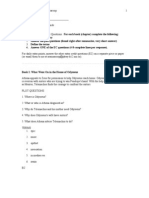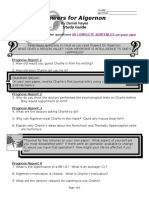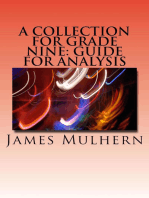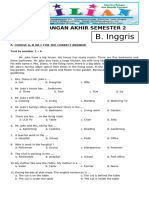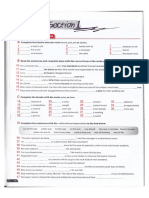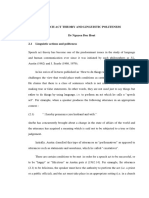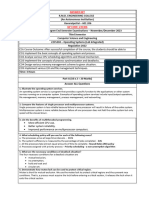The Sniper
The Sniper
Uploaded by
api-266290170Copyright:
Available Formats
The Sniper
The Sniper
Uploaded by
api-266290170Original Title
Copyright
Available Formats
Share this document
Did you find this document useful?
Is this content inappropriate?
Copyright:
Available Formats
The Sniper
The Sniper
Uploaded by
api-266290170Copyright:
Available Formats
unit 4
Text
Analysis
Workshop
Theme and Symbol
A dramatic plot, heart-pounding action, intriguing charactersone or all of these
elements may play a part in capturing, and holding, your interest in a story. Often,
though, stories resonate most when they provide insights into life or human nature.
The meaning behind a work of literature is the theme, the underlying message or
central idea that the writer wants you to remember. Understanding this message
and the writers view of the world is the payoff youll earn for reading carefully.
Part 1: Themes in Literature
Included in this workshop:
RL 2 Determine a theme or
central idea of a text and analyze
in detail its development over
the course of the text, including
how it emerges and is shaped and
refined by specific details; provide
an objective summary of the
text. RL 3 Analyze how complex
characters develop the theme.
Some very old stories have such enduring appeal that they influence works
written many centuries later. One reason these stories remain relevant is that
they feature themes about emotions and experiences that are common across
virtually all time periods and cultures. These universal themes show up again
and again in literaturefrom ancient myths and folktales to todays bestsellers.
examples of universal themes
People can learn from the mistakes
and triumphs of past generations.
When it comes to war, there are no
winners.
Difficult choices are part of growing up.
Love binds people together.
A writer can use virtually every element of a storycharacters, plot, and
settingto develop a theme. To convey a theme about the challenges of
growing up, for example, a writer might craft a story about an insecure
teenager who is plagued by difficult choices. As the character struggles to
resolve the conflicts, he or she may learn a lesson about life.
A writer may also develop a theme through the use of symbols. A symbol is a
person, place, object, or activity that stands for something beyond itself. In the
same story about the doubt-ridden teenager, a writer may use the following
symbols to communicate the theme without having to directly state it:
a fork in the road (an important decision)
the color red (a characters anger at the world)
a torrential rainstorm (an emotional upheaval)
434
unit 4: theme and symbol
model: theme and symbol
Some symbols, like the ivy leaf in this story, are hard not to notice.
The story is about Johnsy and Sue, two artists who become friends while
living in New York City. When Johnsy becomes sick with pneumonia,
she sinks into a deep depression. How does the symbol help you to
understand Johnsys emotions?
from
Short story by O. Henry
10
15
20
25
30
Couldnt you draw in the other room? asked Johnsy, coldly.
Id rather be here by you, said Sue. Besides, I dont want you to keep
looking at those silly ivy leaves.
Tell me as soon as you have finished, said Johnsy, closing her eyes, and
lying white and still as a fallen statue, because I want to see the last one fall.
Im tired of waiting. Im tired of thinking. I want to turn loose my hold on
everything, and go sailing down, down, just like one of those poor,
tired leaves. . . .
Close Read
1. Reread lines 48. How do
the ivy leaves symbolize
Johnsy and her feelings
about life?
When Sue awoke from an hours sleep the next morning she found Johnsy
with dull, wide-open eyes staring at the drawn green shade.
Pull it up; I want to see, she ordered, in a whisper.
Wearily Sue obeyed.
But, lo! after the beating rain and fierce gusts of wind that had endured
through the livelong night, there yet stood out against the brick wall one ivy
leaf. It was the last on the vine. Still dark green near its stem, but with its
serrated edges tinted with the yellow of dissolution and decay, it hung bravely
from a branch some twenty feet above the ground.
It is the last one, said Johnsy. I thought it would surely fall during the
night. I heard the wind. It will fall to-day, and I shall die at the same time. . . .
2. Examine the boxed
description of the last leaf.
Which words or phrases
might also be used to
describe Johnsy? Explain.
The day wore away, and even through the twilight they could see the lone
ivy leaf clinging to its stem against the wall. And then, with the coming of
the night the north wind was again loosed, while the rain still beat against the
windows and pattered down from the low Dutch eaves.
When it was light enough Johnsy, the merciless, commanded that the shade
be raised.
The ivy leaf was still there.
Johnsy lay for a long time looking at it. And then she called to Sue, who was
stirring her chicken broth over the gas stove.
Ive been a bad girl, Sudie, said Johnsy. Something has made that last leaf
stay there to show me how wicked I was. It is a sin to want to die.
3. The theme emerges in
lines 2930. Summarize
and explain what the
writer is saying about how
people should view life.
How does the symbol help
to convey the theme?
text analysis workshop
435
Part 2: Determine Theme
Writers rarely state a works theme directly. More often, the theme is implied. You
have to analyze layers of clues to see what they reveal about the theme. As you
try to uncover the theme of a work, keep these guidelines in mind:
It is helpful to summarize the text before you determine its theme. Briefly
retell the storys events, identifying important details, without including your
own opinions.
The theme is not the subject of a work; it is what the work means. Love is
a subject or topic. A theme is the writers insight or idea about love, best
expressed in a sentence or two, such as Love conquers all.
Some works of literature have more than one theme, but in short stories,
usually one theme stands out.
The genre of a work affects the way its theme emerges. For example, a
poem may share a common theme with a story, but the poet uses different
techniques to express that theme.
clues to a storys theme
title
characters
The title may reflect a storys subject
or a significant idea. Ask
Characters can reflect theme by what
they do or say. Ask
What in the story does the title
refer to?
What do the main characters thoughts
and actions reveal about him or her?
Does the title have more than
one meaning?
How does the main character change?
What lessons does the character learn?
What ideas does the title highlight?
plot and conflict
A story revolves around conflicts that
are central to the theme. Ask
What conflicts do the characters face?
How are the conflicts resolved?
Is the resolution portrayed
positively or negatively?
important statements
The narrator or the characters may make
statements that hint at the theme. Ask
What key statements are made by the
characters or the narrator?
What ideas do these statements
emphasize?
436
unit 4: theme and symbol
setting
Setting can convey theme because of
what it means to the characters and
readers. Ask
How does the setting affect the
characters and the plot?
What might the setting represent?
symbols
Characters, conflicts, and settings can
serve as symbols that support the
theme. Ask
What might the characters, conflicts,
and setting represent?
What ideas do these symbols
communicate?
Text Analysis Workshop
Part 3: Analyze the Text
This story takes place in Dublin, Ireland, during a civil war that erupted in 1922.
Hidden by darkness, a sniper waits for his next target. As you read, track the
clues to the theme. What message about war is the writer communicating?
Short story
by Liam OFlaherty
10
15
20
25
30
The long June twilight faded into night. Dublin lay enveloped in darkness,
but for the dim light of the moon, that shone through fleecy clouds, casting
a pale light as of approaching dawn over the streets and the dark waters of the
Liffey. Around the beleaguered Four Courts the heavy guns roared. Here and
there through the city machine guns and rifles broke the silence of the night,
spasmodically, like dogs barking on lone farms. Republicans and Free Staters1
were waging civil war.
On a roof-top near OConnel Bridge, a Republican sniper lay watching.
Beside him lay his rifle and over his shoulders were slung a pair of field-glasses.
His face was the face of a studentthin and ascetic, but his eyes had the cold
gleam of the fanatic. They were deep and thoughtful, the eyes of a man who
is used to looking at death.
He was eating a sandwich hungrily. He had eaten nothing since morning.
He had been too excited to eat. He finished the sandwich, and taking a flask
of whiskey from his pocket, he took a short draught. Then he returned the
flask to his pocket. He paused for a moment, considering whether he should
risk a smoke. It was dangerous. The flash might be seen in the darkness and
there were enemies watching. He decided to take the risk. Placing a cigarette
between his lips, he struck a match, inhaled the smoke hurriedly and put out
the light. Almost immediately, a bullet flattened itself against the parapet2 of
the roof. The sniper took another whiff and put out the cigarette. Then he
swore softly and crawled away to the left.
Cautiously he raised himself and peered over the parapet. There was a
flash and a bullet whizzed over his head. He dropped immediately. He had
seen the flash. It came from the opposite side of the street.
He rolled over the roof to a chimney stack in the rear, and slowly drew
himself up behind it, until his eyes were level with the top of the parapet.
There was nothing to be seenjust the dim outline of the opposite housetop
against the blue sky. His enemy was under cover.
Just then an armored car came across the bridge and advanced slowly up
the street. It stopped on the opposite side of the street fifty yards ahead. The
sniper could hear the dull panting of the motor. His heart beat faster. It was
an enemy car. He wanted to fire, but he knew it was useless. His bullets
would never pierce the steel that covered the grey monster.
Close Read
1. Which setting details in
the first paragraph help
convey a grim, dangerous
picture of war? One
detail has been boxed.
2. Reread the description of
the sniper in lines 818.
Through the character
of the sniper, what
might the writer be
saying about soldiers
who fight in wars?
1. Republicans and Free Staters: The Irish Republican Army (Republicans) wanted
complete independence from England. The Irish Free Staters wanted Ireland to
govern itself but still remain part of the British Empire.
2. parapet: a low wall along the edge of a roof or balcony.
text analysis workshop
437
35
40
45
50
55
60
65
70
75
438
Then round the corner of a side street came an old woman, her head
covered by a tattered shawl. She began to talk to the man in the turret of the
car. She was pointing to the roof where the sniper lay. An informer.
The turret opened. A mans head and shoulders appeared, looking towards
the sniper. The sniper raised his rifle and fired. The head fell heavily on the
turret wall. The woman darted toward the side street. The sniper fired again.
The woman whirled round and fell with a shriek into the gutter.
Suddenly from the opposite roof a shot rang out and the sniper dropped his
rifle with a curse. The rifle clattered to the roof. The sniper thought the noise
would wake the dead. He stopped to pick the rifle up. He couldnt lift it. His
forearm was dead. . . . He muttered, Im hit.
Dropping flat on to the roof, he crawled back to the parapet. With his left
hand he felt the injured right forearm. The blood was oozing through the
sleeve of his coat. There was no painjust a deadened sensation, as if the arm
had been cut off.
Quickly he drew his knife from his pocket, opened it on the breastwork of
the parapet and ripped open the sleeve. There was a small hole where the bullet
had entered. On the other side there was no hole. The bullet had lodged in the
bone. It must have fractured it. He bent the arm below the wound. The arm
bent back easily. He ground his teeth to overcome the pain.
Then, taking out his field dressing, he ripped open the packet with his
knife. He broke the neck of the iodine bottle and let the bitter fluid drip into
the wound. A paroxysm of pain swept through him. He placed the cotton
wadding over the wound and wrapped the dressing over it. He tied the end
with his teeth.
Then he lay still against the parapet, and closing his eyes, he made an effort
of will to overcome the pain.
n the street beneath all was still. The armored car had retired speedily over
the bridge, with the machine gunners head hanging lifeless over the turret.
The womans corpse lay still in the gutter.
The sniper lay for a long time nursing his wounded arm and planning
escape. Morning must not find him wounded on the roof. The enemy on the
opposite roof covered his escape. He must kill that enemy and he could not use
his rifle. He had only a revolver to do it. Then he thought of a plan.
Taking off his cap, he placed it over the muzzle of his rifle. Then he pushed
the rifle slowly upwards over the parapet, until the cap was visible from the
opposite side of the street. Almost immediately there was a report, and a
bullet pierced the center of the cap. The sniper slanted the rifle forward. The
cap slipped down into the street. Then, catching the rifle in the middle, the
sniper dropped his left hand over the roof and let it hang, lifelessly. After a few
moments he let the rifle drop to the street. Then he sank to the roof, dragging
his hand with him.
Crawling quickly to the left, he peered up at the corner of the roof. His
ruse had succeeded. The other sniper seeing the cap and rifle fall, thought that
unit 4: theme and symbol
Close Read
3. Why does the sniper
shoot the man in the
armored car and the
woman? Explain how
you think the writer
wants you to feel about
the snipers actions.
4. What conflicts are
created by the presence
of the enemy sniper?
5. Notice how the sniper
refers to the other sniper
only as the enemy in
lines 6568. In what ways
might this help the sniper
be effective in war?
Text Analysis Workshop
80
85
90
95
100
105
110
115
120
he had killed his man. He was now standing before a row of chimney pots,
looking across, with his head clearly silhouetted against the western sky.
The Republican sniper smiled and lifted his revolver above the edge of the
parapet. The distance was about fifty yardsa hard shot in the dim light, and
his right arm was paining him. . . . He took a steady aim. His hand trembled
with eagerness. Pressing his lips together, he took a deep breath through his
nostrils and fired. He was almost deafened with the report and his arm shook
with the recoil.
hen, when the smoke cleared, he peered across and uttered a cry of joy.
His enemy had been hit. He was reeling over the parapet in his death
agony. He struggled to keep his feet, but he was slowly falling forward,
as if in a dream. The rifle fell from his grasp, hit the parapet, fell over, bounded
off the pole of a barbers shop beneath and then clattered on to the pavement.
Then the dying man on the roof crumpled up and fell forward. The body
turned over and over in space and hit the ground with a dull thud. Then it
lay still.
The sniper looked at his enemy falling and he shuddered. The lust of battle
died in him. He became bitten by remorse. The sweat stood out in beads on
his forehead. Weakened by his wound and the long summer day of fasting and
watching on the roof, he revolted from the sight of the shattered mass of his
dead enemy. His teeth chattered. He began to gibber to himself, cursing the
war, cursing himself, cursing everybody.
He looked at the smoking revolver in his hand and with an oath he hurled
it to the roof at his feet. The revolver went off with the concussion, and the
bullet whizzed past the snipers head. He was frightened back to his senses by
the shock. His nerves steadied. The cloud of fear scattered from his mind and
he laughed.
Taking the whiskey flask from his pocket, he emptied it at a draught.
He felt reckless under the influence of the spirits. He decided to leave the roof
and look for his company commander to report. Everywhere around was quiet.
There was not much danger in going through the streets. He picked up his
revolver and put it in his pocket. Then he crawled down through the sky-light
to the house underneath.
When the sniper reached the laneway on the street level, he felt a sudden
curiosity as to the identity of the enemy sniper whom he had killed. He
decided that he was a good shot whoever he was. He wondered if he knew
him. Perhaps he had been in his own company before the split in the army.
He decided to risk going over to have a look at him. He peered around the
corner into OConnell Street. In the upper part of the street there was heavy
firing, but around here all was quiet.
The sniper darted across the street. A machine gun tore up the
ground around him with a hail of bullets, but he escaped. He threw
himself face downwards beside the corpse. The machine gun stopped.
Then the sniper turned over the dead body and looked into his
brothers face.
Close Read
6. How does the Republican
sniper resolve his conflict
with the second sniper?
7. Reread the boxed text.
How does the sniper
change after seeing
his enemy fall?
8. Which details in lines
112116 tell you that the
sniper starts to realize his
fallen enemy is a human
being? Explain.
9. Consider the last line of
the story and the clues
you noticed while reading.
What is the writer saying
about war? State the
theme and summarize
details that helped you
understand it.
text analysis workshop
439
You might also like
- What's Wrong With Holding A: Grudge ?Document20 pagesWhat's Wrong With Holding A: Grudge ?Bekki Vanderlende100% (4)
- Hobbit Day Event KitDocument23 pagesHobbit Day Event KitHoughton Mifflin HarcourtNo ratings yet
- Foreshadowing Activity The VeldtDocument2 pagesForeshadowing Activity The Veldtapi-29290165867% (3)
- Lit17 Ak G7u2Document52 pagesLit17 Ak G7u2Maimona KhanNo ratings yet
- Figurative Language Activity-SpeakDocument2 pagesFigurative Language Activity-SpeakAndrea Hernandez-Vila100% (1)
- Hailey Kroischke - Facing It TpcasttDocument3 pagesHailey Kroischke - Facing It Tpcasttapi-525640158No ratings yet
- Explorers 3 Assesment Pack Elephants ChildDocument5 pagesExplorers 3 Assesment Pack Elephants ChildveritoNo ratings yet
- 4-14 AP Practice-Thatcher ConclusionDocument2 pages4-14 AP Practice-Thatcher ConclusionAnastasiya Markova0% (1)
- Poetry Terms PacketDocument2 pagesPoetry Terms PacketKellie Clark100% (1)
- Tuck Everlasting Final Test, Literacy, AR QuestionsDocument2 pagesTuck Everlasting Final Test, Literacy, AR QuestionsPim van den Berg100% (3)
- The Kite Runner-1Document6 pagesThe Kite Runner-1el04927567No ratings yet
- Most Dangerous Game Dialectical JournalDocument3 pagesMost Dangerous Game Dialectical JournaloconeeteacherNo ratings yet
- Embedding Quotations QuizDocument5 pagesEmbedding Quotations QuizPaige NicoleNo ratings yet
- Doing Nothing Is Something. Lesson - StoryDocument14 pagesDoing Nothing Is Something. Lesson - StoryfyiitsmeNo ratings yet
- Fahrenheit 451 Character Analysis - Guy MontagDocument1 pageFahrenheit 451 Character Analysis - Guy Montagapi-518636927No ratings yet
- Holes Chapters 29-34 PDFDocument1 pageHoles Chapters 29-34 PDFFatme Casal0% (1)
- La - Literature - The Time Machine - Chapter 4Document6 pagesLa - Literature - The Time Machine - Chapter 4api-238179390No ratings yet
- The Narrative of The Life of Frederick Douglass TemplateDocument5 pagesThe Narrative of The Life of Frederick Douglass TemplateKristina LaueNo ratings yet
- Liam OflahertyDocument4 pagesLiam Oflahertyapi-252753916No ratings yet
- Stories - The Interlopers by SakiDocument5 pagesStories - The Interlopers by SakiEnglish Plus PodcastNo ratings yet
- MarigoldsquizDocument1 pageMarigoldsquizapi-233694703No ratings yet
- Reading Guide There Will Come Soft RainsDocument11 pagesReading Guide There Will Come Soft Rainsapi-301715107No ratings yet
- Unit Plan - The CayDocument21 pagesUnit Plan - The Cayapi-332192735No ratings yet
- Odyssey Study Guide 09Document20 pagesOdyssey Study Guide 09grace_bollmanNo ratings yet
- The Cask of AmontilladoDocument13 pagesThe Cask of Amontilladocandias9344100% (1)
- There Will Come Soft Rains: Previewing TextsDocument4 pagesThere Will Come Soft Rains: Previewing TextsNatella ManafovaNo ratings yet
- Picture Poem Lesson Plan - DanDocument3 pagesPicture Poem Lesson Plan - Danteacherjohnson100% (2)
- PEE Paragraphs GatsbyDocument8 pagesPEE Paragraphs GatsbyJordan Clark100% (1)
- 10 Day Lesson PlanDocument17 pages10 Day Lesson PlanMary J RichmondNo ratings yet
- Ap English Language AP Exam Study Guide 2Document1 pageAp English Language AP Exam Study Guide 2got2sail100% (1)
- A Raisin in The Sun: Teaching UnitDocument7 pagesA Raisin in The Sun: Teaching UnitGerry Cel E CorpuzNo ratings yet
- La - Literature - The Time Machine - Chapter 11Document6 pagesLa - Literature - The Time Machine - Chapter 11api-238179390No ratings yet
- Shakespeareansonnets StudentbookpagesDocument10 pagesShakespeareansonnets Studentbookpagesapi-309791983No ratings yet
- Reading - FFA - Study Guide and JournalsDocument6 pagesReading - FFA - Study Guide and JournalsDamian NowakNo ratings yet
- The Most Dangerous Game - Discussion QuestionsDocument2 pagesThe Most Dangerous Game - Discussion QuestionsWillNo ratings yet
- Name: Period: Flowers For AlgernonDocument4 pagesName: Period: Flowers For AlgernonomarNo ratings yet
- "The Sieve and The Sand" Quiz: 1. Who Says The FollowingDocument3 pages"The Sieve and The Sand" Quiz: 1. Who Says The Followingapi-302368259No ratings yet
- Animal Farm Final Study GuideDocument2 pagesAnimal Farm Final Study GuideBurgandy SNo ratings yet
- Daughter of Invention - QuestionsDocument2 pagesDaughter of Invention - QuestionsBrandon BrunetteNo ratings yet
- Crucible Student PKT Final FillableDocument17 pagesCrucible Student PKT Final Fillablekolewillis102No ratings yet
- The HitchhikerDocument1 pageThe HitchhikerMinialaNo ratings yet
- 2015 Released Items Ela g6Document46 pages2015 Released Items Ela g6Alfonso Allister Smith50% (4)
- TN Thefivepeopleyoumeetinheaven PDFDocument6 pagesTN Thefivepeopleyoumeetinheaven PDFDave HontiverosNo ratings yet
- The Most Dangerous Game MatchingDocument1 pageThe Most Dangerous Game Matchingecmaddocks0% (1)
- 2019 Scoring Materials Ela g7 PDFDocument104 pages2019 Scoring Materials Ela g7 PDFCameron JohanningNo ratings yet
- Animal Farm Board Game Answer Sheet1Document2 pagesAnimal Farm Board Game Answer Sheet1Ines Diaz100% (1)
- Anticipation Guide Book ThiefDocument3 pagesAnticipation Guide Book ThiefNightwing10No ratings yet
- The Lady or The Tiger Study Guide PDFDocument8 pagesThe Lady or The Tiger Study Guide PDFA. A. Suleiman100% (1)
- The Drummer Boy of Shiloh (Short Analysis KEY)Document5 pagesThe Drummer Boy of Shiloh (Short Analysis KEY)David Velez Gonzalez0% (2)
- RTQGR 10 ElaDocument50 pagesRTQGR 10 ElashawkNo ratings yet
- Of Mice and Men Pre-Reading HyperdocDocument5 pagesOf Mice and Men Pre-Reading Hyperdocapi-253387038No ratings yet
- Final English 2b Assignment SubmitDocument18 pagesFinal English 2b Assignment Submitapi-357329019No ratings yet
- Analysis of PoetryDocument6 pagesAnalysis of PoetryKhalil Al ghulNo ratings yet
- Full Text of Greta ThunbergDocument2 pagesFull Text of Greta ThunbergAkseeb Jawed - 73413/TCHR/BBECNo ratings yet
- Figurativelanguage-BAYU, Ayu, ReyDocument26 pagesFigurativelanguage-BAYU, Ayu, Reyifat jannahNo ratings yet
- Reading ComprehensionDocument1 pageReading ComprehensionLouise YongcoNo ratings yet
- Dark They Were Golden EyedDocument6 pagesDark They Were Golden EyedHafiz AhmedNo ratings yet
- SR7 The Necklace NotesDocument3 pagesSR7 The Necklace Notespinashah2102No ratings yet
- ENG1D - The Flowers WorksheetDocument2 pagesENG1D - The Flowers WorksheetwingnutmommaNo ratings yet
- Quack Volume 1-5Document1 pageQuack Volume 1-5api-266290170No ratings yet
- Multidimensional Fluency Rubric 4 FactorsDocument1 pageMultidimensional Fluency Rubric 4 Factorsapi-266290170No ratings yet
- ApecDocument2 pagesApecapi-266290170No ratings yet
- Interlopers IrDocument6 pagesInterlopers Irapi-266290170No ratings yet
- StatusoftheclassDocument1 pageStatusoftheclassapi-266290170No ratings yet
- Poe PoetryDocument9 pagesPoe Poetryapi-266290170No ratings yet
- Most Dangerous Game Definitions Matching WorksheetDocument1 pageMost Dangerous Game Definitions Matching Worksheetapi-266290170No ratings yet
- Word of The Year Quotes E10Document2 pagesWord of The Year Quotes E10api-266290170No ratings yet
- 2nd Semester Book LogDocument2 pages2nd Semester Book Logapi-266290170No ratings yet
- Thank You MaamDocument11 pagesThank You Maamapi-294720120No ratings yet
- Basic News WritingDocument2 pagesBasic News Writingapi-266290170No ratings yet
- Inverted PyramidDocument1 pageInverted Pyramidapi-266290170No ratings yet
- Elements of The News Sue Barr NeatDocument4 pagesElements of The News Sue Barr Neatapi-266290170No ratings yet
- Lecture Notes FinalDocument29 pagesLecture Notes FinalIlma ČeljoNo ratings yet
- Worksheet 3 More About Scratch Final PDFDocument2 pagesWorksheet 3 More About Scratch Final PDFRaj MalkanNo ratings yet
- SequencesDocument68 pagesSequencesSubrahmanyam SanaNo ratings yet
- Soal UAS Bahasa Inggris Kelas 5 SD Semester 2 Dan Kunci JawabanDocument5 pagesSoal UAS Bahasa Inggris Kelas 5 SD Semester 2 Dan Kunci JawabanM Alfian SamudraNo ratings yet
- Meru University: 3/27/2023 9:03:25 AM P.O. Box 972 MeruDocument2 pagesMeru University: 3/27/2023 9:03:25 AM P.O. Box 972 MeruZephaniah Uwezo (Sultanuwezo)No ratings yet
- CN Lab Questions Anna UniversityDocument4 pagesCN Lab Questions Anna UniversitysandhyaNo ratings yet
- Appositives MatchDocument2 pagesAppositives MatchMilkyWay JonesNo ratings yet
- Language, Culture and IdentityDocument4 pagesLanguage, Culture and IdentityMarlon RamtahalNo ratings yet
- Microcontroller-Based Single-Phase Automatic Voltage RegulatorDocument5 pagesMicrocontroller-Based Single-Phase Automatic Voltage RegulatorFuh ValleryNo ratings yet
- Log Configuration For SEEBURGER AdaptersDocument13 pagesLog Configuration For SEEBURGER AdapterskemoT1990TMNo ratings yet
- Classical Tradition Weekly Reading PDFDocument5 pagesClassical Tradition Weekly Reading PDFLalaNo ratings yet
- Book Inglés I-Basic Unit 2 y 3 Basic Lets Learn English BookDocument30 pagesBook Inglés I-Basic Unit 2 y 3 Basic Lets Learn English BookGARI JOSE APFATA AGUILARNo ratings yet
- Untethered Minds: Issociation and The Onsequences of NowledgeDocument12 pagesUntethered Minds: Issociation and The Onsequences of NowledgeCédric LecanteNo ratings yet
- Sat English 4 Q2Document5 pagesSat English 4 Q2Prescy Grace D. BommosaoNo ratings yet
- Christmas Lesson Plan Ideas: Video Clip VocabularyDocument5 pagesChristmas Lesson Plan Ideas: Video Clip VocabularyDarina BashevaNo ratings yet
- Collocations/Expressions: A Leave, Put, Set ShakeDocument5 pagesCollocations/Expressions: A Leave, Put, Set ShakeTIENMINH NGUYENNo ratings yet
- Note Assistant: Important Notes For SAP - BASIS 730,731,740,750,751,752,753,754,755,756,757,758Document25 pagesNote Assistant: Important Notes For SAP - BASIS 730,731,740,750,751,752,753,754,755,756,757,758parisa10201497No ratings yet
- Resumen JavaDocument38 pagesResumen Javawalter ismael sagastegui lescanoNo ratings yet
- ECCD ChecklistDocument2 pagesECCD ChecklistGlenn CamachoNo ratings yet
- Bridget Elizabeth Mastrorilli: Educational TheatreDocument1 pageBridget Elizabeth Mastrorilli: Educational TheatreBridget ElizabethNo ratings yet
- Lesson 15 - Pop Sound (K and G Sounds)Document9 pagesLesson 15 - Pop Sound (K and G Sounds)Desfika UtamiNo ratings yet
- Game Shark FFTDocument98 pagesGame Shark FFTBiasa LahNo ratings yet
- Guia de Estudio English AdvancedDocument4 pagesGuia de Estudio English Advancedaguilarnayely661No ratings yet
- AJASD Vol21 No2 June 2021-15Document20 pagesAJASD Vol21 No2 June 2021-15YUSUF SARKINGOBIRNo ratings yet
- Ystem Configuration For EucalyptusDocument7 pagesYstem Configuration For EucalyptusSaravanaRaajaaNo ratings yet
- Chap2 - Politeness Notions - HoatDocument61 pagesChap2 - Politeness Notions - HoatTran Minh ThanhNo ratings yet
- AA. VV. - A Companion To The Works of Heinrich HeineDocument389 pagesAA. VV. - A Companion To The Works of Heinrich HeineCarlos WagnerNo ratings yet
- 22CS304 - Operating Systems (Lab Integrated) - Answer KeyDocument13 pages22CS304 - Operating Systems (Lab Integrated) - Answer KeysaraswathiNo ratings yet
- Ulangan Harian Perfect Tense - Conditional SentencesDocument3 pagesUlangan Harian Perfect Tense - Conditional SentencesBayu Pradana PutraNo ratings yet
- 1 Logarithm of Numbers Less Than One 1726822031Document7 pages1 Logarithm of Numbers Less Than One 1726822031kingdenex1No ratings yet























